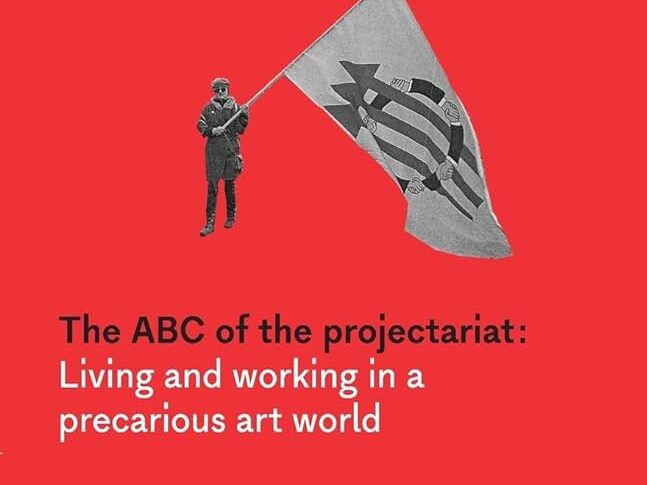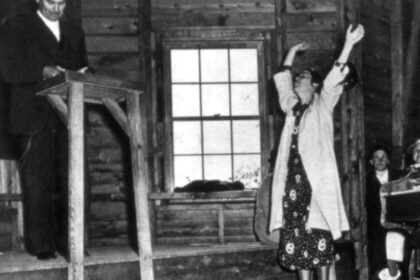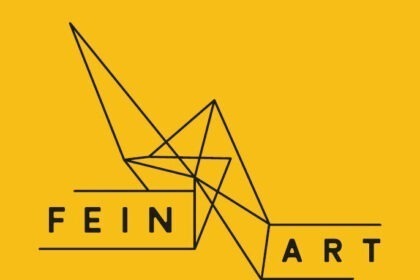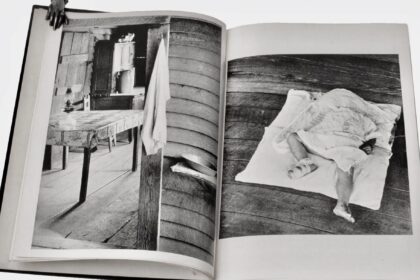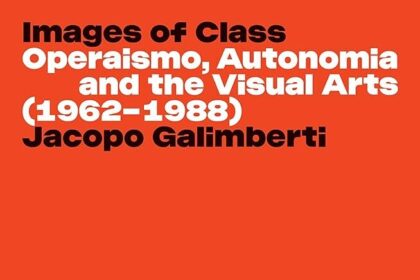Book Review: The ABC of the Projectariat: Living and Working in a Precarious Art World by Kuba Szreder (Manchester: Manchester University Press, 2021).
Kim Charnley
Kuba Szreder’s book The ABC of the Projectariat is a study of the labor politics of contemporary art in the form of a compendium of short to medium-length entries, arranged alphabetically. Szreder includes in the category “projectariat” those artists, curators, academics, writers, assistants, and technicians who earn their livelihood moving between short-term contracts or commissions, the point being, of course, that this is the vast majority of art professionals. Projectarians experience a contradictory privilege; often highly mobile, they are carried in the international circuits of contemporary art along with some of the wealthiest of the so-called ‘1%’, but their work is insecure. Typically, they are also laden with debt incurred to pay for the educational credentials required to access this mobile existence. Consequently, the specter of impoverishment looms as each project ends, a threat that became all too clear during the enforced lockdowns of the COVID-19 pandemic [1].
Szreder’s book is not a traditional academic study of artistic labor, but rather a “theoretically-infused diary,” documenting critical reflection on the author’s experience as a curator, activist, and academic, which draws on collectively undertaken enquiry by artists into their working conditions [2]. The insights the book contains are illuminating because they are closely linked to practice, and because the book documents the vitality of art activism on questions of artistic labor since the Great Crash of 2008. Szreder’s emphasis falls on the fact that the international art world involves a politics of labor that is just another version of the insecure gig-economy that is typical of contemporary capitalism. Indeed, the conjunction between art and labor politics is an important factor in the increased visibility of political aesthetics in the wake of 2008. The ABC of the Projectariat is accordingly an attempt to identify among art workers a way of understanding their own experience “as a sub-species of a larger group of precarious workers” [8].
Although the title refers to the book as an “ABC,” it is clearly not a primer on work conditions that art professionals understand only too well. Rather, it explores the subjective “perils and attractions of artistic labour [sic]”, to better understand how exploitative working conditions are perpetuated and how they might be transformed [3]. Many entries vividly evoke a working life on the brink of burn-out, where projectarians are compelled to be always visible, in the knowledge that this is the only way for another project to arrive. The goal is to survive and to build one’s CV so that, one day, a secure job might come along. The dubious privileges associated with careers in contemporary art arrive by way of intense competition. The global art system is supposedly a meritocracy but, as often as not, it is nothing of the sort. Private wealth, or access to networks through family contacts, tends to provide a decisive advantage in securing the relatively few steady jobs that exist. The purpose of the ABC then is to unlearn the beliefs that naturalize this system, which depends on individualistic models of creative talent and achievement. Szreder makes the ever-sound argument that working conditions only improve because of workplace organizing. Also, he draws on the work of Feminist Marxist theorist Silvia Federici to argue that collective labor can institute a “commons:” a shared space where contributors, freed from the divisive individualism of the art system, might realize their creative and political potential. [4]
Each entry in the book is cross-referenced to others, sending the reader along chains of association intended to suggest “the distributed and ruptured patterns of living and working as a projectarian” [5]. Some entries speak to working conditions, and others explain theoretical concepts or explore the methods activist artists have employed to address their labor conditions. The book addresses the theoretical and practical work of Precarious Workers Brigade, the Artists’ Union in the UK (this organization existed first in the 1970s, but it was revived in 2013), W.A.G.E (Working Artists for the Greater Economy) in the USA, and in Szreder’s native Poland the Citizens Forum for Contemporary Art and the Workers’ Initiative trade union, to draw just a few examples from the many cited. [6] The book also gives a prominent place to the work of theorist and art activist Gregory Sholette, whose work on “dark matter” vividly evokes the labor exploitation that fuels the art system [7].
The book situates its argument about recent art in a much longer debate about artists’ relationship to the proletariat which can be traced to the 1920s. Szreder notes that the idea of an “art worker” emerged originally in the Constructivist and Productivist avant-gardes of this time. It was closely linked to social realist aesthetic positions during the Popular Front era, such as the Congress of Cultural Workers in Lviv, where artists and writers declared their solidarity with workers in the 1930s [9]. Szreder also points to the Artist’s Union in the US between 1933 and 1935, which was organized during the Great Depression. More recent manifestations of a comparable workerism, or art-based unionism, include the Art Workers’ Coalition in New York (1969-71), the first iteration of the Artists’ Union in the UK (1972-1984), and the BKR (Beeldende Kunstenaars Regeling) in the Netherlands, a system providing income for artists that operated between 1949 and 1987.
The history of artists’ self-identification as workers has involved different political stakes at different times, but it has always been contentious. There is historical precedent for wages being paid in return for art in the BKR, as well as in the Federal Art Project in the United States, which ran between 1935 and 1943. This policy was also part of the platform of the first iteration of the Artists’ Union in the UK [13]. Nevertheless, as early as the 1920s some militant artists argued that artists were concealing the cultural privileges that they enjoyed when they claimed a proletarian identity. For example, in the 1920s artist Wieland Herzfelde, brother of John Heartfield, stated: “The artist is a worker and, like others, exploited. Nonetheless, he is no proletarian…He has no comrades but only rivals and competitors; his existence is bourgeois” [10]. This problem has often arisen for artists who engage with Marxism, including those in the conceptual art debates in the 1970s around the journals The Fox and Art-Language [11].
A comparable debate surrounded the return to the idea of the art worker since 2008. The call for “wages for artwork” has been a successful organizing platform for groups such as W.A.G.E and the Polish Civic Forum for Contemporary Art over the last decade [12]. However, a number of theorists have questioned whether it is really right to present this campaign as one undertaken by proletarianized workers. For example, artist and theorist Dave Beech judges that a call for wages for artists is essentially a demand for privileged access to surplus value, because artistic labor is not proletarian according to Marx’s account of it [14]. Szreder concedes that artists are not exploited in the same way as proletarians who receive wages that are worth far less than the goods or services that they create. Neither is the work of artists subject to the discipline of production lines or, its contemporary equivalent, the digital surveillance of workers employed in enormous warehouses. He argues, however, that there is political value in claiming a right to wages for artwork, as a challenge to the ideology of market efficiency that, under neoliberalism, is promoted as the basic rationale for every public good. Although Szreder does not spell out this point in his answer to Beech, The ABC of the Projectariat also demonstrates the reason why many artists and academics are, in fact, under threat of proletarianization. In between short-term contracts, many projectarians support themselves as gig workers, or in other workplaces that are organized capitalistically. Art activists often work in solidarity with museum guards, cleaners, and others who are involved in labor struggles, for this reason.
More significant perhaps than definitions of class are the political actions that artists could mobilize. The book documents, for example, the “Anti-Fascist year”, a project that took place in Poland between 2019 and 2020, its beginning synchronized to the 80th anniversary of the outbreak of the Second World War and its conclusion to the 75th anniversary of the war’s end [15]. The project included cultural institutions, NGOs, and grass-roots organizations, all of them committed to resisting the resurgence of nationalist and neo-fascist rhetoric and policies in Europe. Since 2015, Poland has been governed by a populist right-wing coalition led by the Law and Justice party (Prawo i Sprawiedliwość), which was an early example of the general movement toward authoritarian right-wing government in Europe and globally. Indeed, the Polish administration, along with that of Hungary, provides a model for resurgent right-wing movements, because both have mobilized mass support for the repeal of legislation protecting equal rights for minorities, bodily autonomy for women, and protection of migrants. The “Anti-Fascist year” represents an important example of contemporary art activism that responds to a fully embedded reactionary government intent on repealing the small but significant gains of progressive liberalism. Szreder’s reflection on such groups is important at a time when the populist right gathers for another electoral push in the United States.
The viewpoint expressed in The ABC of the Projectariat is shaped by what Szreder calls the “semi-peripheral” experience of a Polish national working in the anglophone art world [16]. Polish citizens enjoy visa-free travel in the European Union and, as Szreder acknowledges, this is a condition of relative privilege, compared to the experience of artists from the global South. Even so, like citizens of other Eastern European countries, Polish nationals have been subject to discrimination, especially in the UK, where they were targeted in the xenophobic discourse surrounding Brexit. Szreder’s nuanced discussion of the artist’s status in the book addresses asymmetries of this kind. Artists from the semi-periphery experience privileges relative to artists who have the ‘wrong’ passports, or artists who are subject to racialization, but they also face marginalization and disadvantage. The political situation of artistic labor, as Szreder argues, is not only shaped by class but also by other factors including nationality, race, and gender [17]. Not all members of the projectariat enjoy the unlimited mobility that is suggested by art’s global itinerary because border regimes impose themselves on contemporary art’s supposedly progressive cosmopolitanism [18].
Perhaps the most sharply ironic concept in the book is ‘Artyzol’, a neologism developed by the collective Free / Slow University of Warsaw by combining the Polish term for artist (artysta) with a brand name for Communist-era insecticide spray, “Muchozol.” The Free / Slow University of Warsaw (Szreder was a founding member of the group) wryly observes that artworld events generate clouds of artyzol, and the intoxicating fumes are typically supposed to sustain art workers in place of actual remuneration [19]. The term ‘artyzol’ vividly evokes the allure of contemporary art, and the strange relationship between toxicity and intoxication that surrounds the international art world. Moreover, it draws an equivalence between a centralized socialist system and its supposed antithesis, the liberal democratic freedoms exemplified by contemporary art. The critical point is that contemporary art’s heady extravaganza of free market values depends on banal exploitation. Worse than that, the projectariat actually produces the artyzol that perpetuates its own exploitation. Thinking through the implications of Szreder’s argument, we might note that contemporary art is now out of step with geopolitical developments. Whereas artyzol creates an image of cosmopolitan freedom that resonated with the expansion of a globalized free market economy, it has become discordant now that the inequality created by neoliberalism is impossible to avoid.
Szreder’s book reflects on this political moment and documents activist projects that have advocated for the economic rights of artists and resisted the anti-migrant, misogynistic, and transphobic turn in contemporary politics. As such, it provides a thought-provoking account of the tensions that have shaped art activism since 2008. The book also documents a period when the limited democratization of art education that arrived after the Second World War has been gradually eroded. It becomes increasingly difficult for artists to survive unless they have familial wealth to support them. By demonstrating how fundamentally economic questions interact with artists’ subjectivity, the ABC of the Projectariat enriches our account of what it means for art to be “socially engaged.” Although questions of dialogue and community are central to socially engaged art, this term should also bring into view the economic and institutional relations that are expressed in art’s funding and commissioning. It is, of course, easier to make this general recommendation than it is to grapple with the contradictions that Szreder explores. Szeder’s book demonstrates why these contradictions are fundamental issues affecting the political character of contemporary art in all its diverse manifestations, including socially engaged art.
Kim Charnley is author of Sociopolitical Aesthetics: Art, Crisis and Neoliberalism (Bloomsbury, 2021) and lecturer at the Open University. He is a theorist and art historian who researches socially engaged art, social practice, art activism, and institutional critique.
Notes
[1] Kuba Szreder, The ABC of the Projectariat: Living and working in a precarious art world, by Kuba Szreder (Manchester: Manchester University Press, 2021). Kindle edition, p. viii.
[2] Szreder, p. xi.
[3] Szreder p. xi.
[4] See: Szreder, ‘I is for Instituting the Commons’ pp. 128-134.
[5] Szreder, p. ix.
[6] Szreder, p.30.
[7] Szreder, ‘D is for Dark Matter’ pp. 78-79; Gregory Sholette, Dark Matter: Art and Politics in the Age of Enterprise Culture (London: Pluto Press, 2011); Sholette, Delirium and Resistance: Activist art and the Crisis of Capitalism (London: Pluto Press, 2017).
[8] Szreder, p. 30.
[9] Szreder, p. 58.
[10] Herzefelde cited in Sabine Hake, “Proletarian Modernism and the Politics of Emotion: On Franz Wilhelm Seiwert and John Heartfield,” Modernism / modernity Vol.27, no.4 (November 2020), pp 735-767. DOI: https://doi.org/10.1353/mod.2020.0061, p.736.
[11] See: Robert Bailey, Art & Language International: Conceptual Art between Art Worlds (Durham and London: Duke University Press, 2016); Kim Charnley, Sociopolitical Aesthetics: Art, Crisis and Neoliberalism(London: Bloomsbury, 2021) especially Chapter One, “The art collective as impurity.”
[12] Szreder, ‘W is for Wages (for artwork)’, pp. 238-241.
[13] See, for example, the MayDay rooms archive: Artists Union – MayDayRooms
[14] Dave Beech cited in Szreder, p.31; See also: Dave Beech, Art and Labour: On the Hostility to Handicraft, Aesthetic Labour and the Politics of Work in Art (Chicago: Haymarket Press, 2021).
[15] Szreder, ‘A is for Anti-Fascist year’, pp. 6-9.
[16] Szreder, ‘S is for Semi-peripheries’, pp. 212-213.
[17] For example: Szreder, ‘K is for no kids’, pp. 140-143.
[18] Szreder, ‘B is for (no) borders’, pp. 41-42.
[19] Szreder, ‘A is for Artyzol’, pp. 15-17.

